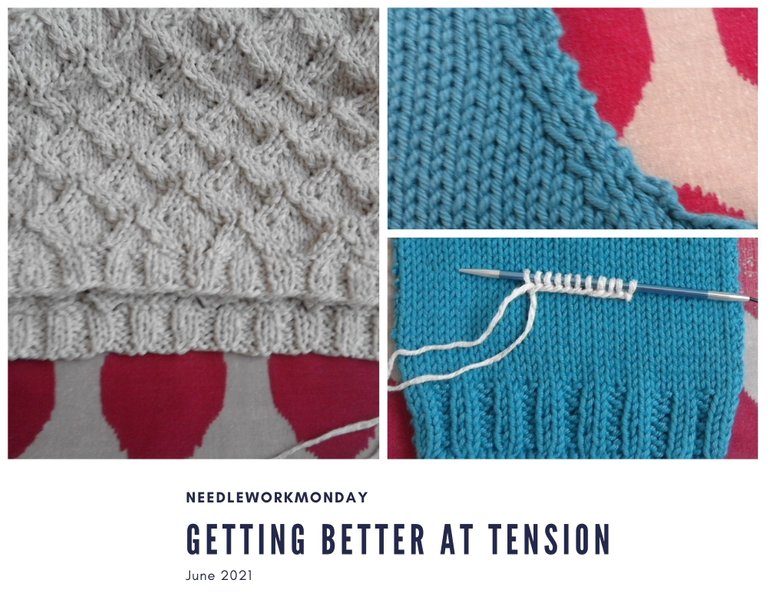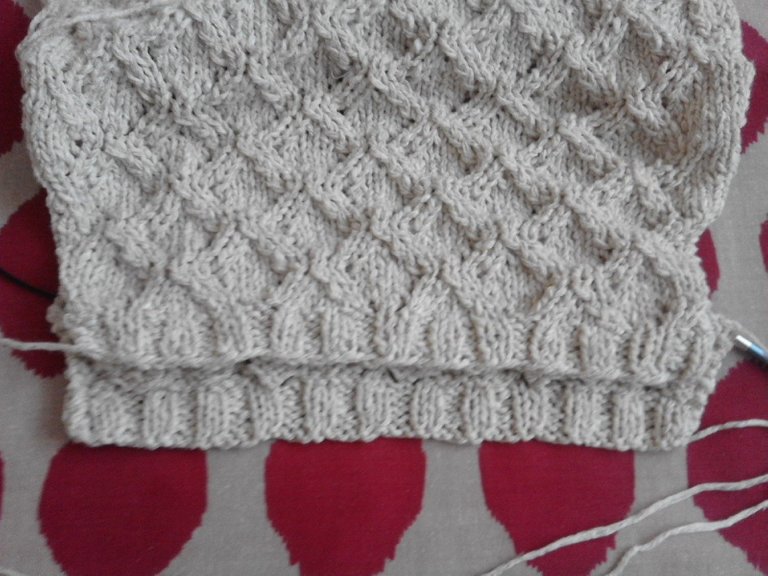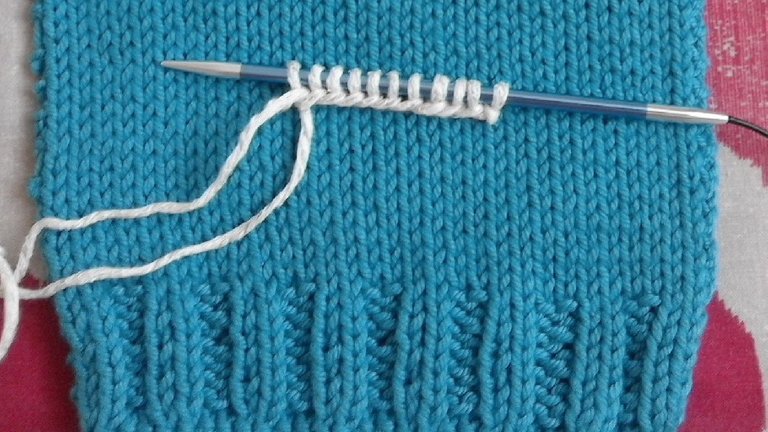#needleworkmonday | Getting Better at Tension in Knitting

I love the rhythmic feel of knitting but, try as I might, I was having trouble with tension. The edges were raggedy and uneven and so were stitches, I was often getting several large stitches at the end of rows, and my cables were all over the place.
Knitting tension does get better over time the more you do it, and as you get used the different types of needle (aluminium, wooden, bamboo, plastic) and how they worked with different types of yarn. Knitting with a slippery silk yarn on smooth aluminium needles is an interesting experience 😵.
But even so, I was struggling to get the finished look I wanted. I do like hand knitted garments to look hand knitted. I find real beauty in their quirks and I enjoy it when I leave behind tiny errors - a brioche stitch done the wrong way round - the mark of the maker, a unique piece.
Some people are able to knit beautiful garments, perfect in every way, with perfectly even stitches, especially important for fully-fashioned sweaters and cardigans. But I'm not quite that chic, I'm more urban 😂 .
But still, I wanted more mastery and control over my materials, to create the more rugged urban effects I wanted rather than having homespun as my only option.
I spent a lot of time over the winter, when it was dark and grey and too cold to enjoy being outside much, practising my tension. I did some research on the Internet and after a few false starts trying techniques that distracted from the rhthym (like knitting close to the points of the needles), I found the formula for me.

My current knitting, showing the front and back and the effect on the bottom edge of using the long-tail cast on method - long Vs on the front, and bobbly purls on the back (or you can reverse them if you choose).
It turns out it's dead simple to get a nice even tension throughout your knitting with lovely straight edges and no yawning, wandering stitches at the ends of the row:
Knit the first and last stitch of every row counter-clockwise.
Knit the second and third stitches on knit rows counter-clockwise.
Purl the second and third stitches on purl rows clockwise.
Knit on knit rows and purl on purl rows into the back of the last three stitches.
As well as looking much more beautiful (like you meant to do it), is that your stitch tension is more likely to be correct so your garment will actually fit you, and you will still enjoy your own rhythmic knitting style.
You can neaten ribbing, cables and knit and purl patterns by:
Knitting a knit stitch immediately before a purl stitch counter-clockwise.
On the following row, knit (or purl) into the back of the reversed stitch(es).
You have to knit in the back of the reversed stitch otherwise you will end up with twisted stitches - unless that's the effect that you want 😍.
What these techniques do is to use a shorter length of yarn to create each stitch that is knitted the opposite way to normal (whether clockwise or counter-clockwise). This pulls extra yarn outer of the row and prevents larger stitches appearing at the end of the row, especially. There are other methods of getting better and more even tension and nice straight edges, but this is the one that works for me, especially as a very loose knitter.
You can finish the edges using stocking stitch (starting and finishing with knit stitches on knit rows and purl stitches on purl rows), which will give an edge with a set of V stitches rather than the little pearl knots. These are good, too, and can be worked using the reverse stitch method for either knit or purl stitches to ensure even tension and straight edges.

Here's a plain stocking stitch sample using the reverse stitch approach for the ribbing and at the beginning and ending of rows. I was so pleased with the even look of the knitting. I also learned a technique for getting better tension in cast on edges.
I tend to use the long-tail cast on method because you get a nice edge and it's stretchy. But I had a problem that my cast on edge was often shorter than the overall knitting width. I learned that I was pulling my stitches way too tight.
When you cast on, you need to stretch out the stitches, leaving a space about the same width as the cast on stitch (or even slightly bigger). That's because when the stitch is knitted, it turns sideways and takes up more room.
In the picture above, I've shown the cast in stitches stretched out to match the knitted stitches underneath. You can see where I've tried to line up each cast on stitch with a knitted stitch behind it. The cast on stitches are still a little tight, especially the nearer to the end you get.
Along the left and right edges of the knitting you can see the little knots created by finishing every row with a knit stitch. These look like little seed pearls down the sides of the knitting. I think they look so pretty, and it is very easy to count rows. I've also been learning how to join these stitches so you get a nice smooth seam.
It does seem to be in knitting that literally every stitch counts.
Saturday Savers Club
I run a savings club every Saturday over on the @eddie-earner account. We're aiming to save £670 ($800) by the end of the year using the 365 day savings challenge. You can join any time of the year and set your own goals and plans (some people are saving Hive, others Bitcoin, some their local currency). We share savings tips and there's a free giveaway every week.
Three things newbies should do in their first week and, for most things, forever afterwards!

Hi @shanibeer,
Thank you for participating in the #teamuk curated tag. We have upvoted your quality content.
For more information visit our discord https://discord.gg/8CVx2Am
Thank you @teamuksupport, good to see you 😍
I have the reverse problem - I'm so used to tension being dictated by knitting needles, I struggle sometimes with tension in crochet. It's all just freeform! Willy nilly! Madness! 😉
Tho I did make a towel in blocks of 5x5 knit/pearl squares, and I ended up making the blocks do, well, this:
...it turned out OK, it just was a happy accident that I think was due to my tension slipping when I switched back and forth, lol.
Me too! I enjoy crochet, but not as much as knitting. I find I am often holding my breath with crochet (too much tension)? 😂
Yeah, I recognise that sloping! But I'm sure it works as a towel, and those zig-zags are a perfect design feature.
!ENGAGE 20
ENGAGEtokens.Thank you... I am maybe more like rural style 🤣
But I learn every day, that about the edges it is a big thing I always worry, and more than once I ad to remake a entire piece...
So Thank you!! 💚
This is what I was finding, too - nothing glamorous or chic!
I agree - I have been doing a lot of undoing, especially as I have got better. I keep remaking things I had started before I learned these techniques and re-making them.
On the other hand, it is very cheap remaking things as you never have to buy new yarn! 😂.
!ENGAGE 20
ENGAGEtokens.Wow, your blue sample looks perfect. Every stitch is neat and wonderful and I get envious!!! A LOT! My problem are not the sides of the fabric but the knitting itself. I always have a slight rowing out and I really tried… I tried the german style of knitting, the Norwegian purl and now combination knitting. The latter is so far the best for my fingers because it does not hurt too fast, but still I have these uneven stitches. But your knitting, again: wow. It is so even. I was fascinated to read about the border stitches and the twisting. It really works in your sample. I seldom use border stitches? (Randmaschen in German) because I find it harder to knit them together later. But so far I am not too annoyed with the fabric sides (or I am too inattentive to recognise that they are sloppy)
Sadly I cannot use your technique with combination knitting (or can I … hmmm have to think again) as I in general twist and untwist my stitches in every row.
And with the casting on (and also casting off) I am a tad boring, I always use the same techniques and your trial is a good reminder to experiment.
I always crochet my stitches on with a bigger hook than needle and this seems to work ok for me, but I never looked at my ribbing with the same analytical method like you. (I need to learn to read my knitting better)
Here is a view of the ribbing of my latest cardigan, for me the cast on seems to be stretchy enough… hmmm.
So much to learn (for me), thank you for these new techniques!!!
Hello sister knitter! We're learning together 😍
The first three stitches are not border stitches - the first one is the selvedge that will be taken into the seam (or left on a button band, I guess)😁. The next two stitches are knitted in the pattern and are part of the fabric of the garment. Only the way the stitches are made is different.
I thought this technique would only work with English knitting, but then I noticed someone showing the technique with the yarn in their left hand (Continental, right)? I know that you twist and untwist your stitches in combination knitting ... I think possibly you do the opposite of what you would normally do as you create the stitch, and then reverse what you would do in the following row when you come back to knit or purl into that stitch? (I don't know combination knitting, so I couldn't work out the twists and untwists) 😂.
Your edging looks okay to me, there is only the slight unevenness between the rows, but you know, I would let that pass, too!
The blue is the wool I have bought for testing out the perfect cardigan design, once I have formulated it from the experimental lace pattern one. I am just about to attempt the sleeve top shaping in the experiment. I have knitted both sleeves to the underarm cast off so far.
Can you do a post about how you cast on with a crochet hook? That sounds interesting. In one of my knitting groups, one woman was very happy to tell me there were 52 (or some such) methods of casting on and even more methods of casting off. I never saw her again after that.
Love, love, love these conversations x
Metooooooo (the knit or crochet technique talk) love. I will look into these edge stitches later, because I rally love how neat your fabric looks. But right now I have to hurry to the garden and check if the water container flooded 😱
WIth the crochet cast on... I have made two videos on this long ago :-DDDD They are not the best but here you are :
Western stitch mount (I think this is the right one, when you want to proceed with knit stitches in English or continental knitting)
ANd cast on for eastern stitch mount (for English or continental, if you want to go on with purl stitches)
I use a crochet hook which is one or 1,5 sizes bigger, but to be honest, I also used the same size in hook and needles and it worked too (for me)
I think in general the technique is named "provisional cast on" but for me it was so natural as I like to crochet and was too lazy to learn something new :-D
!ENGAGE 30
ENGAGEtokens.Great that you could do knitting so well.. i cannot do knitting :'
Thank you 😍. My dad taught me when I was a little girl - he learned to knit when he was a little boy. He and his brothers knitted their own socks.
Would you like to learn knitting? It is quite easy and inexpensive and doesn't need a lot of equipment. Can you crochet?
!ENGAGE 15
You're welcome :). Glad that you have your own guru, your father :).
I once tried to do that, but when i was a child. But i am not sure that was knitting or crocheting. What is the different between knitting and crocheting?
In knitting, generally, you use two needles, or a circular needle, where two end needles are joined by a cable.
In crochet, generally, you use a single crochet hook.
In both cases, I believe there are exceptions 😂.
If you look at @neumansalva's post this week, she has knitting and crochet so you can see the difference in the fabric.
Knitting
Photo by Hello I'm Nik on Unsplash
Crochet
Photo by Imani on Unsplash
ENGAGEtokens.Thanks
Every knitter has to find a way to get consistent tension--unless they only knit dishcloths. Glad you have found what works for you. !BEER
Yes - I find it very pleasing 🙂.
Hope all is well with you.
!ENGAGE 15
ENGAGEtokens.View or trade
BEER.Hey @shanibeer, here is a little bit of
BEERfrom @fiberfrau for you. Enjoy it!Did you know that you can use BEER at dCity game to **buy dCity NFT cards** to rule the world.
oh my, I remember back at school we had to knit a scarf. Half of it was loose and the other half was super tense 😂 I improved on it of course, but not too much. Yours looks really good!
I know that scarf! 😁
Good to see you @rimicane, how are you?
!ENGAGE 15
ENGAGEtokens.looking at your smiley face in the text, I will not knit slippery silk yarn with aluminum knitting needles))) when you talk about fashionable sweaters knitted in a perfect way, this does not apply to Israel))) it is very difficult to find such things here; people here look at it as unimportant. You do it very well: beautifully and neatly !!! unfortunately, I did not understand the explanation that you wrote because I do not understand English well, and the translator does not translate clearly. but I am grateful to you for the hint where to look for tips for a neater and smoother knitting.
Hello @tali72, so nice to see you.
I agree, sometimes it is complicated, even in English!
But you got the tip about slippery yarn 😍
!ENGAGE 20
ENGAGEtokens.Well done! I find YouTube to be a wealth of knowledge for most things. I remember back in 1984 paying a guy $15 for a half hour guitar lesson. That was no chump change back then. Bow I could learn it all for free!
YouTube is a fabulous resource for just about everything!